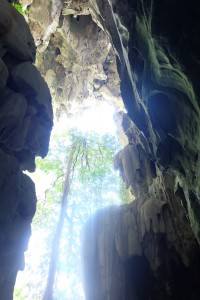Kenyir Lake is the largest man-made lake in South East Asia spanning over 260,000 hectares. It was formed by the damming of several rivers over the period 1978 to 1985 to create the Sultan Mahmud Hydro Electric Power Plant.

HISTORY
Prior to the lakes formation, the area was a centre of early civilization. Caves around the lake, namely Batu Tok Bidan and Gua Bewah, have produced significant archaeological discoveries such as stone tools and axes dating back to the Neolithic era (roughly 10,000 years ago).
When the area was flooded with water between 1978 and 1985 most of the hilltops remained above water level, creating 340 man–made islands. Many unexplored caves, along with Batu Tok Bidan were probably submerged during the creation of Kenyir lake. Only Gua Bewah and Gua Taat remain accessible to the public.
Prior to its inundation during the flooding of the reservoir, Batu Tok Bidan cave was excavated in 1959 by R.Noone, and later by Malaysian Historical Society in 1976. Mollusc shells showing signs of human consumption (tips broken off) discovered at the site suggest it was frequently used as a shelter in the prehistoric past. A Neolithic burial was also found at the site, with broken pottery laid at the foot of the deceased.
In 2010 human skeletal remains believed to be from the Mesolithic Age were found in Gua Bewah Cave. The female skeletal remains were confirmed to be 13,400 years old. In 2012 the media reported the discovery of a second prehistoric skeleton, also in Gua Bewah, and not far from where the first skeleton was found.

KENYIR DAM
The planning and construction of the dam spanned over 15 years starting in 1972 with project surveys. Construction of the main rock fill dam started in 1978 and finished with the dams completion in 1985. It was officially opened in 1987 by the Sultan of Terengganu and was named Sultan Mahmud Hydro Electric Power Station in his honour. The lake can store 13.6 billion cubic metres of water and can produce 100 MW for supply throughout Malaysia.
ECOLOGICAL IMPORTANCE
Kenyir Lake and its surrounding tropical forest is home to an incredibly diverse array of flora and fauna with 2,500 species of plant, 8,000 species of flower, 290 species of birds and 61 recorded species of fish. Many of these species are rare and endemic to this area.

SOCIOECONOMIC IMPORTANCE
Kenyir Lake is a popular ecotourism destination, with thousands visiting each year to take part in activities such as sightseeing, fishing, swimming, jungle trekking and bird watching. In recent years a number of parks (e.g. Mati Island Bird Park) and sanctuaries (e.g. Telemong River Elephant Sacntuary) have been constructed to generate revenue from the influx of tourists whilst also protecting some threatened endemic species. In addition to tourism, the local economy is also driven by commercial fishing and fish production (cage culture).

THREATS AND PROBLEMS
Lake Kenyir is constantly changing. The flooded forest is slowly decaying changing the quality of the water and the characteristics of the underwater habitat. Siltation is changing the nature of the substrate and the topography of the lake bed. These processes potentially threaten capture fisheries and aquaculture and reduce the aesthetic value of the area.
The development of the tourism industry also brings potential threats to production, biodiversity and Kenyir’s aesthetic value. The development of facilities and access cause habitat destruction whilst sewage effluents, solid waste, fertilizers, pesticides, fuels and exhaust fumes damage the natural environment and threaten the ecosystem services the environment provides.
Overfishing, unregulated stocking and aquaculture activities also threaten endemic species through the depletion of fish numbers by capture, competition from introduced species and pollution, disease and infection from cage culture.

